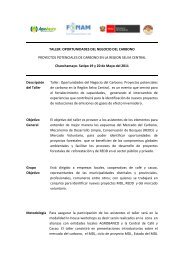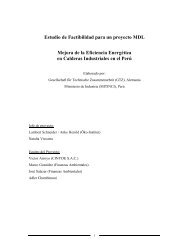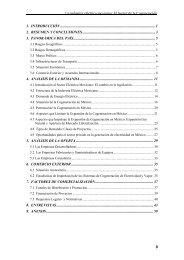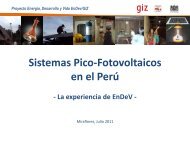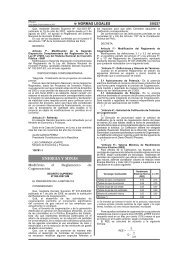Copenhagen Bicycle Account 2002 - Bicycle Network
Copenhagen Bicycle Account 2002 - Bicycle Network
Copenhagen Bicycle Account 2002 - Bicycle Network
Create successful ePaper yourself
Turn your PDF publications into a flip-book with our unique Google optimized e-Paper software.
<strong>Bicycle</strong> <strong>Account</strong> <strong>2002</strong>
Foreword<br />
<strong>Copenhagen</strong>'s image as a city for cyclists is excellent. Nearly 80% of <strong>Copenhagen</strong><br />
cyclists think that <strong>Copenhagen</strong> is a fine city to cycle in – better than other cities.<br />
Since the City of <strong>Copenhagen</strong> started publishing a <strong>Bicycle</strong> <strong>Account</strong> the number<br />
of cyclists has grown. Since the last <strong>Bicycle</strong> <strong>Account</strong> (2000) the number of cyclists<br />
entering and leaving the city centre has increased by 6% and the figure for those<br />
crossing the municipal boundary has increased by 2%.<br />
The City of <strong>Copenhagen</strong> is delighted that so many people ride bicycles as a<br />
means of transport. It is essential that the City continue to work hard to improve<br />
cycling conditions – both in order to ensure good conditions for those who already<br />
cycle and to get even more people to cycle.<br />
In <strong>2002</strong> <strong>Copenhagen</strong> published its first Cycle Policy. Nine focus areas are defined,<br />
intended to ensure that cycling will become safer, that cyclists will feel more secure,<br />
that cyclists will be able to reach their destinations more quickly and that<br />
cycling comfort shall be improved. The City of <strong>Copenhagen</strong> is also drafting a<br />
Traffic and Environment Plan one of whose primary focus areas is the improvement<br />
of cycling conditions. A great deal of attention is thus being paid to the fact<br />
that bicycles are an excellent means of transport with a positive impact on the<br />
urban environment as well as the health of the individual cyclist.<br />
The <strong>Bicycle</strong> <strong>Account</strong> shows whether cyclists are satisfied and it takes stock of the<br />
work being done. The <strong>Bicycle</strong> <strong>Account</strong> is an instrument for <strong>Copenhagen</strong> politicians<br />
to keep an eye on whether the measures taken are satisfactory in relation to<br />
the political objectives and whether the focus areas set forth in the Cycle Policy<br />
should be adjusted.<br />
The explicit goal is that 40% of commuters to workplaces in <strong>Copenhagen</strong> shall<br />
bike to work by 2012. This will require a great deal of work, but I consider it so<br />
essential that I will place great emphasis on its implementation in the next few<br />
years. Happy cycling!<br />
Søren Pind, Mayor for traffic<br />
BICYCLE ACCOUNT <strong>2002</strong><br />
Published in May 2003<br />
City of <strong>Copenhagen</strong><br />
Building and Construction Administration<br />
Roads and Parks Department<br />
Printing: 2000 in Danish, 1000 in English<br />
Translation: Joan Høberg-Petersen<br />
Produced by Grinsted Public A/S<br />
Produced with consideration for the environment<br />
The <strong>Bicycle</strong> <strong>Account</strong> can be ordered from:<br />
Roads and Parks Department<br />
Njalsgade 13,5.<br />
DK-2300 <strong>Copenhagen</strong> S<br />
Denmark<br />
Tel. +45 33 66 35 00<br />
email: vp-publikationer@btf.kk.dk<br />
www.vejpark.kk.dk/CityOfCyclists<br />
2 Foreword
Summary<br />
Purpose<br />
The <strong>Bicycle</strong> <strong>Account</strong> is an account for cyclists and the City of <strong>Copenhagen</strong>,<br />
showing the City's record in the field of cycling. The cyclist section of the account<br />
consists of a survey in which <strong>Copenhagen</strong> cyclists describe how they feel<br />
about cycling in town. The City section of the account is a kind of stocktaking in<br />
which a number of key figures are used to depict conditions which are vital to<br />
cyclists. In addition, the target figures indicate the extent to which the Cycle Policy's<br />
objectives are being achieved. The <strong>Bicycle</strong> <strong>Account</strong> also provides information<br />
about the City's current projects and initiatives within the field of cycling.<br />
The <strong>Bicycle</strong> <strong>Account</strong> covers a two year period and is published in Danish and<br />
English. The next <strong>Bicycle</strong> <strong>Account</strong> is due for publication in the spring of 2005.<br />
What cyclists think<br />
The first section of the <strong>Bicycle</strong> <strong>Account</strong> presents cyclist attitudes and opinions.<br />
As in the previous <strong>Bicycle</strong> <strong>Account</strong>s cyclist attitudes and opinions are gauged by<br />
means of survey interviews. The results are presented in the section entitled<br />
"What cyclists think" and are also listed under the relevent topic in the account.<br />
Cyclist ratings are expressed in a point system depicted graphically as 10 little<br />
cyclists – the more cyclists the better!<br />
Compared with the previous <strong>Bicycle</strong> <strong>Account</strong> certain shifts have occurred. In five<br />
cases the changes registered in <strong>2002</strong> have been so significant that they have<br />
affected the number of "little cyclists":<br />
<strong>Copenhagen</strong> as a city for cylists: 8<br />
Rating unchanged.<br />
Cyclist sense of security: 6<br />
Rating unchanged.<br />
Amount and width of cycle tracks: 5<br />
Lower rating.<br />
Cycle track maintenance: 5<br />
Higher rating.<br />
Road maintenance: 3<br />
Higher rating.<br />
Feasibility of combining cycling with public transport: 5<br />
Rating unchanged.<br />
<strong>Bicycle</strong> parking: 3<br />
Lower rating.<br />
City information on traffic planning: 4<br />
Higher rating.<br />
Summary<br />
3
Key figures<br />
The second part of the <strong>Bicycle</strong> <strong>Account</strong> consists of a number of key figures<br />
which were defined as essential by cyclists in connection with the first <strong>Bicycle</strong><br />
<strong>Account</strong>. A few key figures have been discontinued over the course of time while<br />
a few new ones have been added.<br />
• <strong>Bicycle</strong> traffic has increased by 6% so that 1 million km are now cycled in<br />
<strong>Copenhagen</strong> every day.<br />
• Motor traffic has only increased by 1%.<br />
• The number of km of cycle track has increased by 16 km and is now 323 km.<br />
• The number of km of cycle lane has increased by 2 km and is now 12 km.<br />
• The length of green cycle routes has increased by 1 km and is now 32 km.<br />
• In 2000 DKK 9.1 million was spent on cycle track maintenance while in <strong>2002</strong><br />
only DKK 6.8 million was spent.<br />
• The figure for serious cyclist casualties has risen by 4 so that in <strong>2002</strong> 172 cyclists<br />
were seriously injured.<br />
• Signal intersections with measures for cyclists have increased from 28% of<br />
intersections to 36% of intersections in <strong>2002</strong>.<br />
Cycle Policy target figures<br />
A new feature of the present <strong>Bicycle</strong> <strong>Account</strong> is the introduction of five target<br />
figures which relate directly to the goals set forth in Cycle Policy <strong>2002</strong>–2012.<br />
The target figures indicate to what extent the City is achieving Cycle Policy<br />
goals:<br />
• The proportion of the workforce that cycle to workplaces in <strong>Copenhagen</strong> is<br />
now 32%. This is a slight decrease in relation to the previous <strong>Bicycle</strong> <strong>Account</strong>.<br />
The target goal is that 40% shall bike to work.<br />
• Cyclist risk is now 0.46 serious casualties per 1 million cycle kilometres. The<br />
trend that took place throughout the 1990s, already reducing cyclist risk by<br />
half, continues although the decrease is a only minor one (4%). The target goal<br />
is a 50% reduction by 2012.<br />
• 56% of cyclists feel secure cycling in <strong>Copenhagen</strong> traffic. There was no apparent<br />
change for the better. Work is being done to ensure that a full 80% feel<br />
secure by 2012.<br />
• Cycling speed on trips of over 5 km shall be improved by 10% by 2012. This<br />
objective can not be evaluated yet as a method of registration has to be devised<br />
first.<br />
• The target goal that unsatisfactory cycle track surfaces shall not exceed 5% was<br />
attained in <strong>2002</strong>.<br />
4 Summary
What Cyclists Think<br />
Since 1995 an independent consultancy has carried out five representative surveys<br />
of <strong>Copenhagen</strong> cyclists for the City of <strong>Copenhagen</strong>'s <strong>Bicycle</strong> <strong>Account</strong>. The<br />
most recent survey – in which close to 400 cyclists participated – was done in<br />
the autumn of <strong>2002</strong>. The cyclists involved cycle at least once a week and the<br />
majority almost every day.<br />
10 little cyclists<br />
Cyclists' attitudes are depicted graphically in a rating system of up to 10 little<br />
cyclists. A rating of 10% satisfied cyclists is expressed graphically as one little<br />
cyclist and the full 10 cyclists are only awarded if all or virtually all cyclists are<br />
satisfied. Shifts in the <strong>Bicycle</strong> <strong>Account</strong> since 2000 are summed up on the following<br />
pages.<br />
The system of rating cyclist sense of security has been altered in relation to previous<br />
years. Formerly the number of cyclists was calculated on the basis of how<br />
many answered "Completely" or "Partially" to the question whether they feel<br />
secure. Now only those who unambiguously answer "Completely" are included.<br />
This is intended to bring the assessment in line with the goal for cyclist sense of<br />
security set forth in the City of <strong>Copenhagen</strong> Cycle Policy.<br />
Who cycles in <strong>Copenhagen</strong>?<br />
According to the survey, <strong>Copenhagen</strong> cyclists are young, two thirds of them<br />
being under 40. More women than men cycle in <strong>Copenhagen</strong> – 63% of those<br />
questioned are women. When it comes to occupation most cyclists belong to the<br />
categories salaried or white-collar workers (42%) and students (27%). Men cycle<br />
greater distances than women. One man out of five states that he cycles over 100<br />
km a week.<br />
Why cycle?<br />
The survey shows that the bicycle is most often used to get to and from work,<br />
for excursions, visits, etc. and for shopping and other errands. The most<br />
important reason for choosing to cycle is that it is faster and easier – or for the<br />
exercise. There has been a fall in the proportion of cyclists who say they cycle<br />
because it's easier. Financial reasons plus the fact that cycling is convenient play a<br />
role for many cyclists. When die-hard cyclists occasionally do not cycle, almost<br />
half say that this is due to poor weather conditions.<br />
The bad road manners of other road users has become a serious nuisance<br />
A new aspect is the fact that the bad road manners of other road users has become<br />
the greatest nuisance – 34% of cyclists cite this as a particularly bothersome factor.<br />
Other significant nuisances are "too many cars" (31%), "too many cyclists" (22%),<br />
"not enough cycle tracks" (15%), and "too narrow cycle tracks"(12%).<br />
What Cyclists Think<br />
5
<strong>Copenhagen</strong> as a city of cyclists<br />
<strong>2002</strong><br />
2000<br />
Nearly four out of five cyclists think that <strong>Copenhagen</strong> is excellent, good or fair to<br />
cycle in. Compared to 2000 cyclists have become somewhat less satisfied, a shift<br />
having occurred from good to fair. Men are more satisfied cycling in <strong>Copenhagen</strong><br />
than women.<br />
Cyclist sense of security<br />
<strong>2002</strong><br />
2000<br />
Cyclist sense of security when cycling in <strong>Copenhagen</strong> has not changed significantly<br />
since the last <strong>Bicycle</strong> <strong>Account</strong>. 56% of cyclists feel safe cycling in town and approximately<br />
one fourth (24%) partially safe. Men feel slightly safer than women.The main<br />
reasons for cyclists to feel unsafe are cars (64%), other cyclists (43%) and buses<br />
(26%).<br />
Amount and width of cycle tracks<br />
<strong>2002</strong><br />
2000<br />
58% of cyclists are satisfied or very satisfied with the length of the cycle track<br />
network whereas only 45% are satisfied or very satisfied with cycle track width.The<br />
latter figure is much lower than in 2000. More than one out of three cyclists are dissatisfied<br />
or very dissatisfied with cycle track width. Men are more satisfied than<br />
women with both amount and width.<br />
Cycle track maintenance<br />
<strong>2002</strong><br />
2000<br />
45% of cyclists are satisfied or very satisfied with cycle track maintenance.This is<br />
slightly more than in 2000.<br />
6 What Cyclists Think
Road maintenance<br />
<strong>2002</strong><br />
2000<br />
The proportion of cyclists (28%) who are satisfied with the maintenance of roads<br />
without cycle tracks has increased slightly since 2000.<br />
Feasibility of combining cycling with public transport<br />
<strong>2002</strong><br />
2000<br />
Roughly half of the cyclists (51%) are satisfied with the feasibility of combining<br />
cycling and public transport, which is more or less unchanged since 2000. Slightly<br />
fewer (46%) report that they actually combine cycling with public transport – of<br />
these, half state that this only occurs rarely.Women combine cycling with public<br />
transport more often than men.<br />
<strong>Bicycle</strong> parking<br />
<strong>2002</strong><br />
2000<br />
Satisfaction with bicycle parking facilities in town has fallen compared to 2000 so<br />
that 27% are satisfied now and 55% are dissatisfied.This corresponds more or less<br />
to the degree of satisfaction with bicycle parking facilities at train stations.<br />
City information on traffic planning<br />
<strong>2002</strong><br />
2000<br />
As in 2000, roughly one quarter of the cyclists do not answer the question as to<br />
how they assess the traffic planning information provided by the City of <strong>Copenhagen</strong>.<br />
However, more now tend to think that the information is good or fair. 10%<br />
answer that they know or have heard of the City of <strong>Copenhagen</strong>'s Cycle Policy. In<br />
the cyclist sector, half believe the City will listen when presented with proposals<br />
whereas in the category of motorists and users of public transport only one quarter<br />
and one third respectively think that this serves any purpose.<br />
What Cyclists Think<br />
7
Road User Profile<br />
The survey of <strong>Copenhagen</strong> road users makes it possible to paint a portrait of the<br />
people who choose to cycle, drive or take the bus or train in <strong>Copenhagen</strong>.<br />
The road user group to which the interviewee belongs is defined on the basis of<br />
which the means of transport that he or she considers the primary one.<br />
Children in the household<br />
The majority of road users interviewed in <strong>Copenhagen</strong> have no children. Motorists<br />
are the road user group with the largest number of children per household.<br />
Whereas 45% of motorists have children, this is only true of 19% of those who<br />
take the bus or train and 29% of cyclists.<br />
Household income and occupation<br />
Motorists generally have high incomes. Cyclists on the other hand are characterized<br />
by being evenly distributed throughout all income brackets. The bicyle is<br />
thus a means of transport which appeals to rich and poor alike. Public transport<br />
is not attractive to the well-to-do, and only 18% of users of public transport<br />
have a household income of over DKK 400,000.<br />
Both motorists and cyclists typically have a higher education and most are salaried<br />
or white-collar workers or civil servants. In the cyclist group there are also<br />
many students, school children or apprentices. Almost half of the people using<br />
public transport have the equivalent of a primary school level education.<br />
Age<br />
Half the users of public transport are over 50, which is only the case for 29% of<br />
motorists and 19% of cyclists. 67% of cyclists are under 40.<br />
Children in the household Household income Age<br />
100<br />
90<br />
80<br />
70<br />
60<br />
50<br />
40<br />
30<br />
20<br />
10<br />
0<br />
Public<br />
transport<br />
Cyclists<br />
Motorists<br />
100<br />
90<br />
80<br />
70<br />
60<br />
50<br />
40<br />
30<br />
20<br />
10<br />
0<br />
Public<br />
transport<br />
100<br />
90<br />
80<br />
70<br />
60<br />
50<br />
40<br />
30<br />
20<br />
10<br />
Cyclists Motorists 0<br />
Public<br />
transport<br />
Cyclists<br />
Motorists<br />
2 or more children<br />
1 child<br />
No children<br />
No comment/ Don't know<br />
Over DKK 400,000<br />
DKK 300- 400,000<br />
DKK 200-300,000<br />
DKK 100-200,000<br />
Less than DKK 100,000<br />
Over 60<br />
50-59<br />
40-49<br />
30-39<br />
20-29<br />
16-19<br />
8 Road User Profile
Other Road Users and the <strong>Bicycle</strong><br />
When asked "What could get you to cycle or cycle more, rather than drive or<br />
use public transport?", 38% replied "Absolutely nothing!". This is a higher figure<br />
than in 2000 when this was the answer of only 32%. An additional 15% of<br />
motorists and users of public transport answered "Undecided".<br />
However, half of those who drive or use public transport do have an opinion on<br />
what can get them to cycle (or cycle more). In this category, most motorists cite<br />
more cycle tracks (26%) or better cycle tracks (20%). Many (20%) also cite<br />
shorter distance between home and work, although this answer was not a specified<br />
option in the interview. When it comes to users of public transport most<br />
cite better road manners (18%) and fewer cars in <strong>Copenhagen</strong> (14%). As with<br />
motorists, many users of public transport also cite more cycle tracks (14%) and<br />
better cycle tracks (12%). There are quite a few motorists and users of public<br />
transport (approx. 10%) who say that better weather conditions is the main factor!<br />
<strong>Copenhagen</strong>ers prioritize improved cycling conditions<br />
In connection with the City of <strong>Copenhagen</strong>'s Traffic and Environment Plan<br />
2003 an analysis was made of <strong>Copenhagen</strong>ers' attitudes to various traffic measures.<br />
The study revealed a markedly positive attitude to more cycle tracks, wider<br />
cycle tracks, better maintenance of cycle tracks, better bicycle parking facilities at<br />
suburban train stations and better bicycle parking facilities in the city centre. In<br />
addition, it should be noted that many people expressed a marked desire for better<br />
enforcement of traffic regulations as well as improved cycling conditions at<br />
signal crossings.<br />
How to get other road users to cycle?<br />
As indicated above, certain motorists and users of public transport would cycle<br />
more if there were more and better cycle tracks and other improvements for<br />
cyclists. Better road manners (including enforcement of the traffic regulations)<br />
would also be helpful in this regard. However, a large group of motorists and<br />
users of public transport are highly resistant to the idea of cycling. Mobility<br />
planning at businesses providing assistance to employees in mapping out transport<br />
routes between home and workplace might convince more people that<br />
cycling is an option – at least for part of their journey. Better conditions for<br />
cyclists at workplaces (such as bathing facilities) would effect people's attitudes as<br />
to how far and in what weather conditions cycling to work is an option.<br />
What other road users think of cyclists<br />
In the <strong>Bicycle</strong> <strong>Account</strong> motorists and users of public transport were questioned<br />
about their attitude to cyclist road manners. Half of them agreed or partially<br />
agreed that they were often bothered by cyclists. Approx. 70% thought that<br />
cyclists rarely obey the traffic regulations and approx. 65% thought that cyclists<br />
are often the cause of dangerous situations.<br />
Other Road Users and the <strong>Bicycle</strong><br />
9
More and More Cyclists<br />
Since the last <strong>Bicycle</strong> <strong>Account</strong>, <strong>Copenhagen</strong> bicycle traffic has continued to<br />
grow. The number of cyclists crossing the municipal boundary on a weekday has<br />
increased by almost 2%, while the number crossing the ring around the inner<br />
city has increased by almost 6%. The greatest growth has thus occurred in the<br />
inner section of <strong>Copenhagen</strong>.<br />
Motor traffic only increased by 1.5% since 2000 both at the municipal boundary<br />
and at the ring around the inner city.<br />
Increase in number of kilometres cycled<br />
The number of kilometres cycled or driven is calculated on the basis of figures for<br />
the major road network (regional roads, primary roads and distributor roads).<br />
The number of kilometres cycled has increased by 6% since the last <strong>Bicycle</strong> <strong>Account</strong><br />
while there has only been a 1% rise in the number of kilometres driven. Since<br />
the first <strong>Bicycle</strong> <strong>Account</strong> of 1995 the number of kilometres cycled has increased<br />
by a full 40% whereas the number of kilometres driven has increased by 16%.<br />
Local streets – i.e. all streets which are not included in the major road network<br />
mentioned above – are not yet included in calculations of number of kilometres<br />
travelled. The octopus shaped figure on the following page illustrates where<br />
cyclists travel on the major road network.<br />
5.0<br />
1.2<br />
Regional roads<br />
Primary roads<br />
Distributor roads<br />
Million km performed by car per day<br />
4.0<br />
3.0<br />
2.0<br />
1.0<br />
Million km performed by bicycle per day<br />
1.0<br />
0.8<br />
0.6<br />
0.4<br />
0.2<br />
95 96 97 98 99 00 01 02<br />
95 96 97 98 99 00 01 02<br />
KEY FIGURES<br />
<strong>Bicycle</strong> traffic<br />
<strong>2002</strong> 1.02 million km per day<br />
2000 0.96 million km per day<br />
Motor traffic<br />
<strong>2002</strong> 4.54 million km per day<br />
2000 4.43 million km per day<br />
10 More and More Cyclists<br />
Cycle to work<br />
<strong>2002</strong> 32%<br />
2000 34%<br />
78% think that <strong>Copenhagen</strong> is excellent, good or fair to cycle in<br />
(unchanged since 2000) whereas 22% think it is poor or very poor.<br />
About 25%, mostly men, have tried cycling in cities abroad, 81% of<br />
whom think that <strong>Copenhagen</strong> is better for cycling than the cities<br />
abroad.
Kongelundsvej<br />
Strandvejen<br />
Frederiksborgvej<br />
Lyngbyvej<br />
Hareskovvej<br />
Mørkhøjvej<br />
Tuborgvej<br />
Frederikssundsvej<br />
<strong>Bicycle</strong> traffic<br />
flows <strong>2002</strong><br />
Slotsherrensvej<br />
Number of bicycles<br />
and mopeds on a<br />
weekday 6 am – 6 pm.<br />
Jyllingevej<br />
2000-3999<br />
4000-5999<br />
6000-7999<br />
8000-9999<br />
10000-11999<br />
12000-13999<br />
14000-15999<br />
16000-17999<br />
18000-24000<br />
Roskildevej<br />
Holmbladsgade<br />
Vigerslev Allé<br />
Gammel Køge Landevej<br />
Kastrupvej<br />
Amagerbrogade<br />
Englandsvej<br />
One third still bike to work<br />
Since the <strong>Bicycle</strong> <strong>Account</strong> 2000 the proportion of those who cycle to and from<br />
work fell slightly from 34% (1999) to 32% (2001). This is despite the fact that<br />
bicycle traffic in the city has generally increased. One explanation could be that the<br />
total number of journeys to and from workplaces in <strong>Copenhagen</strong> has increased.<br />
The increase in the total number of home-workplace trips is primarily due to the<br />
fact that more people have begun to go by train (train traffic in the greater <strong>Copenhagen</strong><br />
area rose, particularly in 2000). Although the number of those who cycle to<br />
and from work is unchanged, the proportion has fallen slightly.<br />
It is the explicit goal of the Cycle Policy that the proportion of people cycling to<br />
workplaces in <strong>Copenhagen</strong> shall increase to 40% by 2012. This is an ambitious<br />
objective seen in relation to how things have developed since the first <strong>Bicycle</strong><br />
<strong>Account</strong> of 1995 when 31% cycled to work, and sustained and serious efforts<br />
will be required to achieve it.<br />
New bicycles as part of the street scene<br />
<strong>Bicycle</strong> messengers have been part of the <strong>Copenhagen</strong> street scene for a long<br />
time and play an important role for the <strong>Copenhagen</strong> traffic environment because<br />
their numerous trips are primarily carried out in the most densely populated<br />
sections of town, trips which would otherwise most likely have been carried out<br />
by taxi or van. In previous <strong>Bicycle</strong> <strong>Account</strong>s there used to be a key figure for the<br />
number of trips carried out by bicycle messengers. This key figure has been<br />
discontinued in the present <strong>Bicycle</strong> <strong>Account</strong> partly because it is difficult to get<br />
reliable figures and partly to make room for other, more topical key figures.<br />
In 2001 a new alternative to taxis was launched and there are now bicycle rickshaws<br />
on the roads and cycle tracks of <strong>Copenhagen</strong>. <strong>Bicycle</strong> rickshaws serve as<br />
ordinary taxis for passengers as well as delivery vans, thereby contributing to a<br />
better environment. They do, however, create problems in certain areas due to<br />
their size as it can be difficult to pass them on narrow cycle track sections.<br />
More and More Cyclists<br />
11
Cycle tracks and reinforced cycle lanes built in 2001 and <strong>2002</strong>:<br />
Classensgade<br />
H.C.Andersens Boulevard near Town Hall Square and Tivoli<br />
Jernbane Allé<br />
Lygten<br />
Tietgensgade<br />
Toftegårds Allé<br />
Vindebrogade<br />
Islands Brygge<br />
Østrigsgade<br />
Ørestads Boulevard<br />
Grønjordsvej<br />
Arne Jacobsens Allé<br />
Klaksvigsgade<br />
Weidekampsgade<br />
12<br />
Better Cycling Infrastructure
Better Cycling Infrastructure<br />
Length of the cycle track network<br />
Cyclists are quite satisfied with the length of the cycle track network, but there is<br />
still work to be done. The City of <strong>Copenhagen</strong>'s cycle tracks, which were built<br />
in the course of 100 years, provide ample opportunity for mapping out safe and<br />
secure routes, to work, for example. More cycle tracks and cycle lanes are in the<br />
planning stage. The Cycle Track Priority Plan <strong>2002</strong>-2016 was passed in 2001.<br />
The plan calls for 51 km of new cycle tracks, reinforced cycle lanes, etc. The aim<br />
of the plan is to establish the comparatively cheaper reinforced cycle lanes as a<br />
temporary measure as quickly as possible wherever feasible. Proper cycle tracks<br />
are to be established as quickly as possible on the most difficult sections. Short<br />
sections linking together the rest of the cycle track network have high priority, as<br />
do sections travelled by many cyclists.<br />
Since 2000 nearly 2 km of reinforced cycle lanes and 16 km of cycle tracks have<br />
been built. A large portion of the new cycle tracks are in the areas of new urban<br />
development (Ørestad and the Ny Tøjhus site). Cycle tracks in these two areas<br />
are not included in the Cycle Track Priority Plan.<br />
Some of the sections which have been built in the rest of the city are quite short.<br />
They have, however, addressed essential issues for cyclists and have served to link<br />
the other sections more effectively. This applies to a short section of cycle track<br />
on H.C. Andersens Boulevard near the central Town Hall Square, for example.<br />
In 2003-2004 a number of new cycle tracks and reinforced cycle lanes are<br />
projected, primarily in the city centre: Slotsholmen, Vindebrogade, Gothersgade,<br />
Enghavevej, Backersvej and Vermlandsgade.<br />
Cycle track width<br />
Queues on certain cycle tracks during rush hours may be the reason why cyclists<br />
in the <strong>Bicycle</strong> <strong>Account</strong> survey express their dissatisfaction with the width of cycle<br />
tracks. The increase in bicycle traffic is especially marked in the densely populated<br />
urban areas of <strong>Copenhagen</strong> and a first analysis indicates that during the<br />
rush hour there are capacity issues on 2-3 km of cycle track in these areas, i.e.<br />
the inner sections of Nørrebrogade and Østerbrogade, Frederiksborggade, Torvegade<br />
and possibly a few other places. The problems are due to the fact that a<br />
"two lane" cycle track ( 2.2 m in width) can only handle approximately 2,000<br />
cyclists per hour. In the innermost sections of Nørrebrogade there are roughly<br />
2,300 cyclists in the morning rush hour – the capacity limit is thus exceeded<br />
resulting in queues or very low speeds. A "three lane" cycle track (which is<br />
approx. 3 metres wide) would be able to handle 3,500 cyclists during peak<br />
hours, which presumably would provide sufficient capacity several years ahead.<br />
Better Cycling Infrastructure<br />
13
Green cycle routes<br />
Green cycle routes are intended as a new option for cyclists, allowing them to<br />
cycle in more peaceful surroundings both when it comes to Sunday excursions<br />
and the daily trip to and from work. The plan for green cycle routes, which calls<br />
for 100 km, is intended in the long run to ensure that the cycle routes can be<br />
established.<br />
The length of the green cycle route network has increased since 2000 by slightly<br />
more than 1 kilometre since the Nørrebro route has continued to be extended.<br />
In <strong>2002</strong> there are thus 32 km of green cycle routes.<br />
The Nørrebro route will be extended in accordance with the politically approved<br />
phase plan. It is proposed in the Cycle Policy that a similar phase plan should be<br />
drawn up for the Amager route. One section of the Amager route is currently<br />
being built in connection with construction of the Ny Tøjhus site at Islands<br />
Brygge.<br />
Several of the links across the harbour included in the Cycle Route Plan have<br />
become topical in connection with the Opera House, Teglværkshavnen and the<br />
Fisketorvet shopping mall. It appears that it may be possible to finance these<br />
links in connection with the urban development taking place in these areas.<br />
Work is being done to implement the Christianshavns route, the Kastrup Fort<br />
route and the University route, which include the above-mentioned cross harbour<br />
links.<br />
GREEN CYCLE ROUTES<br />
Green cycle routes are a new key figure in the <strong>Bicycle</strong><br />
<strong>Account</strong>, as the key figure has hitherto merely included<br />
the length of the green cycle track network generally.<br />
From now on the key figure will show the City's total<br />
green cycle route network in kilometres.<br />
KEY FIGURES<br />
Length of cycle tracks:<br />
<strong>2002</strong> 323 km<br />
2000 307 km<br />
Length of cycle lanes:<br />
<strong>2002</strong> 12 km<br />
2000 10 km<br />
Length of green cycle routes:<br />
<strong>2002</strong> 32 km<br />
2000 31 km<br />
Most of the new cycle tracks are in areas of new urban development,<br />
Ørestad and the Ny Tøjhus site.The roads in these areas<br />
are private until further notice, but the major roads – including<br />
cycle tracks – will later become public.<br />
14<br />
Better Cycling Infrastructure
Better conditions for cyclists in the City Centre<br />
The historic city centre is a Cycle Policy focus area. This is due to the fact that a<br />
large number of cyclists travel there, all of whom would benefit from improvements,<br />
such as cycle tracks, cycle link-ups, cycling against traffic in one way<br />
streets, bicycle parking facilities, etc.<br />
Several of the cycle tracks that have been built since 2000 are in the city centre.<br />
Nevertheless, there are a number of difficult sections left in the area, for example<br />
Stormgade, where there is no immediate space for cycle tracks.<br />
The simple cycle lanes which were established on an experimental basis along six<br />
streets in the city centre are to be upgraded into reinforced cycle lanes in accordance<br />
with the Cycle Track Priority Plan. The first of these sections, Tietgensgade,<br />
was provided with proper cycle tracks in <strong>2002</strong>. The cycle lane in Store Kongensgade<br />
is due to be reinforced within a couple of years by establishing short<br />
sections of cycle track at bus stops. In Gothersgade and Lille Kongensgade, in an<br />
attempt to extend and improve cycling link-ups in the city centre, plans have<br />
been drawn up for allowing cyclists to cycle against the one-way traffic.<br />
In the historic city centre cyclists are now allowed to cycle against the traffic in a<br />
number of small streets. In Farvergade, for example, which is included in a future<br />
two-way cycle link-up between Town Hall Square and Kgs. Nytorv, a cycle<br />
lane has been established against the one-way traffic.<br />
There are now 3,300 bicycle parking spaces in the historic city centre, 400 new<br />
spaces having been established within the past year or so. In the rest of the City<br />
Centre and the densely populated areas around it an additional 850 new spaces<br />
have been established.<br />
Cyclists have become less satisfied with the amount and width of<br />
cycle tracks. 58% of cyclists are presently satisfied with the amount<br />
of cycle tracks compared to 66% in 2000. 24% are presently dissatisfied.The<br />
degree of satisfaction with cycle track width has markedly<br />
decreased. Only 45% are currently satisfied with the width of<br />
cycle tracks compared to 62% in 2000. 37% are dissatisfied – compared<br />
to 24% who were dissatisfied in 2000.This change is most<br />
likely due to the cycle track congestion discussed above.<br />
In the survey interviews the various road user groups were asked<br />
whether they had noticed that special efforts have been made for<br />
cyclists in the City Centre over the past couple of years.Almost<br />
half noticed that work has been done – two thirds noticed that<br />
more cycle tracks have been established, while fewer (under 10%)<br />
noticed that more bicycle parking facilities have been set up and<br />
that cyclists are now allowed to cycle against the traffic at certain<br />
points.<br />
Better Cycling Infrastructure<br />
15
Cycle Track Maintenance<br />
In <strong>Copenhagen</strong> there has been a great deal of focus on maintenance of roads and<br />
cycle tracks. It is essential that cycle tracks are well maintained if cyclists are to<br />
feel like cycling. The criticism of poor cycle track maintenance in the previous<br />
<strong>Bicycle</strong> <strong>Account</strong>s has resulted in systematic efforts. This time the cyclists express<br />
their appreciation of the City's efforts since the number of cyclists who are satisfied<br />
with cycle track maintenance has increased since 2000.<br />
Cycling comfort<br />
In the summer of 2000 an inspector cycled up and down all cycle tracks assessing<br />
them in terms of road surface cycling confort. The cycle tracks were assessed again<br />
in 2000 and the result of the City's inititatives appears in the chart below:<br />
Summer 2000 Winter <strong>2002</strong><br />
Completely new or flawless surface 57% 79%<br />
Uneven but acceptable surface 23% 16%<br />
Unsatisfactory surface - extremely unpleasant 10% 5%<br />
The Cycle Policy states that one of the City's goals is to improve cycling comfort<br />
to such a degree that no more than 5% at most of the cycle track network will<br />
have an unsatisfactory surface. This objective has been achieved in <strong>2002</strong>, but<br />
will require continuous work to maintain the proportion of poor cycle tracks at<br />
under 5%.<br />
There are plans for reducing the number of very poor sections in 2003. However,<br />
there are no funds for improving the sections which are not yet completely unacceptable<br />
(although well on the way) – in other words no preventive measures are<br />
provided for. In 2003 slightly over DKK 6.8 m have been earmarked for cycle<br />
track maintenance. Preventive measures would annually cost an extra DKK 2.7 m.<br />
OFF<br />
ON<br />
The "comfortometer"<br />
Previous years' assessments of the standard of cycle track<br />
surfaces were based on comprehensive reconnaissance,<br />
which is of course subjective to a certain degree. The<br />
City has now purchased a "comfortometer", developed<br />
in the Netherlands, which in future will register cycle<br />
track comfort more objectively. The first measurements<br />
will take place in 2003.<br />
The comfortometer is attached to the bicyle's baggage<br />
rack in a small box. When the bicycle is being ridden,<br />
the comfortometer can register the vertical accelerations<br />
that a bicycle undergoes when in motion and thereby<br />
the comfort of the cyclist during the journey. A more<br />
objective and more easily comparable description of the<br />
individual cycle tracks is hereby ensured.<br />
16 Cycle Track Maintenance
KEY FIGURES<br />
Maintenance:<br />
<strong>2002</strong> DKK 6.8 m<br />
2000 DKK 9.1 m<br />
ngc<br />
Cycling comfort:<br />
(cycle tracks with an unsastisfactory surface)<br />
<strong>2002</strong> 5%<br />
<strong>2002</strong> 5%<br />
2000 10%<br />
Cyclists have become more satisfied with the level of comfort.<br />
Only 6% of cyclists say they are disturbed by uneven cycle<br />
tracks whereas 7% are disturbed by uneven road surfaces.<br />
In 2000 the corresponding figures were 13% and 9%. 45% are<br />
satisfied with cycle track maintenance compared to 40% in<br />
2000 – whereas 36% say they are dissatisfied. On roads<br />
without cycle tracks only 28% of cyclists are satisfied with<br />
maintenance which, however, is better than in 2000 when<br />
only 23% were satisfied.<br />
Cycle Track Maintenance<br />
17
Cycling Saves Many Lives<br />
There are significant health benefits to be derived from moderate excercise, such<br />
as cycling to work. From a social point of view the health benefits derived from<br />
cycling in the form of enhanced quality of life and lives saved vastly exceeds the<br />
risk of being injured or killed in traffic. For the individual, too, health and wellbeing<br />
are a significant argument for cycling. Naturally everything possible must<br />
be done to reduce the number of casualties. The best way to do this is to define<br />
objectives that are both ambitious and realistic.<br />
Aims<br />
The City of <strong>Copenhagen</strong> has two explicit target goals for reducing cyclist casualties:<br />
• The number of seriously injured cyclists shall be reduced by 40% in the period<br />
2001-2012, in accordance with the Road Safety Plan for <strong>Copenhagen</strong>.<br />
• Cyclist risk (measured per cycled kilometre) shall be reduced by half by 2012,<br />
in accordance with the Cycle Policy.<br />
Serious casualties<br />
In the course of the past 10 years the number of seriously injured cyclists was<br />
reduced by 25%. In <strong>2002</strong> the police registered 172 serious cyclist casualties (the<br />
figure is adjusted.). 4 cyclists were killed in <strong>Copenhagen</strong> traffic in <strong>2002</strong>. A 4%<br />
reduction in cyclist risk occurred between 2000 and <strong>2002</strong>.<br />
Pedestrians Motorists and motorcyclists Cyclists<br />
250<br />
200<br />
150<br />
100<br />
50<br />
250<br />
200<br />
150<br />
100<br />
50<br />
300<br />
250<br />
200<br />
150<br />
100<br />
50<br />
92 93 94 95 96 97 98 99 00 01<br />
92 93 94 95 96 97 98 99 00 01<br />
92 93 94 95 96 97 98 99 00 01<br />
KEY FIGURES<br />
Serious cyclist casualties<br />
<strong>2002</strong> 172<br />
2000 168<br />
The key figure for signal intersections shows the percentage of signal<br />
intersections at which measures have been taken to regulate cyclist<br />
safety, security and ease of passage.The key figure no longer provides<br />
an adequate picture of cycling improvements at signal intersections.<br />
Intersections with measures for cyclists:<br />
<strong>2002</strong> 36%<br />
2000 28%<br />
18 Cycling Saves Many Lives
Cyclists are the focus of special attention in the City's Road Safety Plan since<br />
reduction of the number of cyclist casualties is defined as an area of special focus<br />
(see the above-mentioned aims).<br />
Roughly two thirds of all serious cyclist casualties occur at intersections, which is<br />
why a great deal of effort is being put into intersection improvements. In <strong>2002</strong><br />
the situation is that safety measures have been taken at 36% of city intersections.<br />
In 2001 and <strong>2002</strong> a great many blue marked crossings were established. One of<br />
the challenges at intersections is to improve cyclist safety and sense of security<br />
without reducing ease of passage for cyclists. Alterations in the key figure are<br />
under consideration for the next <strong>Bicycle</strong> <strong>Account</strong> so as to cast more light on this<br />
issue.<br />
The risk of injury<br />
For a <strong>Copenhagen</strong> cyclist the risk of being injured or killed<br />
in traffic has been reduced by almost half during the course<br />
of the past 10 years. Part of this is doubtless due to<br />
improvements for cyclists in the traffic environment, but it<br />
may also be due to the fact that when the number of cyclists<br />
increases, the risk to the individual cyclist is significantly<br />
reduced.<br />
Sense of security<br />
Security is the cyclist's subjective sense of the risk of being<br />
run over. This perception can be based on actual experience<br />
in dangerous traffic situations or merely a feeling. The<br />
Risk of injury: Number of serious cyclist<br />
casualties per 1 m km.<br />
more one cycles, the safer one feels. Only half of the road users who are primarily<br />
motorists or users of public transport, or who only cycle rarely, feel secure<br />
while cycling. This feeling of insecurity may be a factor in their decision not to<br />
cycle.<br />
Campaigns such as "We bike to work" may help provide new personal experiences<br />
and change attitudes so that even more people will dare cycle in <strong>Copenhagen</strong>.<br />
1.0<br />
0.9<br />
0.8<br />
0.7<br />
0.6<br />
0.5<br />
0.4<br />
0.3<br />
0.2<br />
0.1<br />
90 91 92 93 94 95 96 97 98<br />
99 00 01 02<br />
KEY FIGURES<br />
Risk:<br />
(serious cyclist casualties per 1 million cycle kilometres)<br />
<strong>2002</strong> 0.46<br />
2000 0.48<br />
Security:<br />
<strong>2002</strong> 56%<br />
2000 57%<br />
56% of cyclists feel secure cycling in <strong>Copenhagen</strong> while another<br />
26% feel partially secure. Only 18% feel insecure.This corresponds<br />
more or less to the last <strong>Bicycle</strong> <strong>Account</strong> for 2000.<br />
The primary reason for cyclists to feel insecure or partially insecure<br />
is cars (64%), but other cyclists (43%) and buses (26%) also<br />
play a role. 13% of cyclists say that they have been injured in a<br />
traffic accident within the past two years.<br />
Cycling Saves Many Lives<br />
19
Will we Achieve our Goals?<br />
In <strong>2002</strong> for the first time the City of <strong>Copenhagen</strong> published a Cycle Policy<br />
including objectives and focus areas. The City is also drafting a Traffic and Environment<br />
Plan. The <strong>Bicycle</strong> <strong>Account</strong> evaluates the Cycle Policy’s target figures<br />
and provides a basis for making adjustments in the work being done.<br />
Cycle Policy<br />
The Cycle Policy <strong>2002</strong>-2012 draws attention to cycling as an environmentally<br />
desirable and effective means of transport and coordinates initiatives for improving<br />
cycling conditions. Quantitative objectives have been formulated to the<br />
effect that more people shall cycle, risk shall be cut in half, sense of security<br />
improved, travelling speed and comfort increased. Systematic efforts will be<br />
made in nine focus areas.<br />
Drafting the Cycle Policy has provided an excellent opportunity for considering<br />
cycling conditions in a broader perspective. Establishing cycle tracks along the<br />
roads is not enough – a continuous cycling network must be provided for cyclists<br />
based on transport quality including safety, security, travelling speed, health,<br />
comfort and cycling pleasure.<br />
Follow-up on the Cycle Policy's goals and initiatives<br />
The <strong>Bicycle</strong> <strong>Account</strong> is used to keep an eye on the work being done to achieve<br />
the Cycle Policy goals. Activities have to be adjusted along the way so as to create<br />
optimal cycling conditions within the limits of the allocated resources.<br />
The Cycle Policy target figures are followed in the <strong>Bicycle</strong> <strong>Account</strong> to monitor<br />
how well Cycle Policy goals are being achieved.<br />
• The proportion of people cycling to workplaces in <strong>Copenhagen</strong> was 32% in<br />
<strong>2002</strong>. This is a slight fall compared to the last <strong>Bicycle</strong> <strong>Account</strong> when the figure<br />
was 34% (1999) and unfortunately a change for the worse.<br />
• In <strong>2002</strong> cyclist risk was 0.46 serious cyclist casualties per 1 million cycle kilometres.<br />
Taking the year 2000 as the starting point for risk, a 4% risk reduction<br />
occurred in <strong>2002</strong>. This is a continuation of the 1990s trend, which reduced<br />
cyclist risk by half.<br />
THE CYCLE POLICY'S FIVE GOALS<br />
• The proportion of people cycling to workplaces in <strong>Copenhagen</strong><br />
shall increase from 34% to 40%.<br />
• Cyclist risk of serious injury or death shall decrease by 50%.This<br />
is the equivalent of 84 serious cyclist casualties.<br />
• The proportion of <strong>Copenhagen</strong> cyclists who feel safe cycling in<br />
town shall increase from 57% to 80%.<br />
• Cyclist travelling speed on trips of over 5 km shall increase by<br />
10%.<br />
• Cycling comfort shall be improved so that cycle track surfaces<br />
deemed unsatisfactory shall not exceed 5%.<br />
20 Will we Achieve our Goals?
• In <strong>2002</strong> 56% of cyclists said they feel safe cycling in <strong>Copenhagen</strong> traffic. This<br />
is not a positive shift in relation to 57% in 2000.<br />
• Cyclist travelling speeds for trips of over 5 km shall be improved by 10% by<br />
2012. This goal can not yet be assessed as a registration technique must first be<br />
developed.<br />
• The goal that sections of unsatisfactory cycle track surfaces shall not exceed 5%<br />
was achieved in <strong>2002</strong>.<br />
The Traffic and Environment Plan 2003 focuses on cycling<br />
It is easy to forget on a daily basis that <strong>Copenhagen</strong> bicycle traffic contributes<br />
significantly to the relatively excellent state of the city's environment and its traffic<br />
situation. While bicycle traffic has fallen in the rest of the country, <strong>Copenhagen</strong><br />
(along with other cities making a concentrated effort for bicycle traffic) has<br />
experienced a rise.<br />
It has become apparent that the citizens of <strong>Copenhagen</strong> place a high priority on<br />
good cycling conditions. The proposal for the Traffic and Environment Plan<br />
2003 is expected to recommend:<br />
• Building more cycle tracks and reinforced cycle lanes<br />
• Widening 2-3 km of cycle tracks<br />
• Building more cycle routes<br />
• Improving bicycle parking facilities<br />
• Allocating more resources for cycle track maintenance<br />
A proposal for the Traffic and Environment Plan is expected to be submitted for<br />
public hearing in August 2003.<br />
THE CYCLE POLICY'S NINE FOCUS AREAS:<br />
• Cycle tracks and reinforced cycle lanes<br />
• More green cycle routes<br />
• Improved cycling conditions in the city centre<br />
• Improved feasibility of combining cycling and public transport<br />
• More and better bicycle parking facilities<br />
• Better signal intersections<br />
• Better cycle track maintenance<br />
• Better cycle track cleaning<br />
• Campaigns and information<br />
Will we Achieve our Goals?<br />
21
Looking ahead to the <strong>Bicycle</strong> <strong>Account</strong> for 2004 – initiatives in the field of<br />
cycling<br />
A more rapid extension of the cycle track and reinforced cycle lane network<br />
would make it possible to achieve the Cycle Policy objective that 80% of <strong>Copenhagen</strong>ers<br />
are to feel safe cycling in <strong>Copenhagen</strong>. If no more facilites are provided,<br />
most of the <strong>Copenhagen</strong>ers who do not cycle at all will continue to feel insecure<br />
at the thought of cycling in <strong>Copenhagen</strong>. Widening the cycle tracks that are<br />
congested would also remove a source of irritation for many cyclists.<br />
More green cycle routes will enhance the perception that cycling is recognized as<br />
an independent means of transport in <strong>Copenhagen</strong>. In time cycle routes will<br />
provide commuters and weekend cyclists with an opportunity to travel around<br />
<strong>Copenhagen</strong> in peaceful, green surroundings.<br />
Campaigns such as the Environmental Transportation week (during which traffic<br />
solutions are tested in practice and there is a focus on transport habits) and "We<br />
bike to work" campaigns can provide more people with the opportunity of seeing<br />
for themselves how delightful cycling in <strong>Copenhagen</strong> can be. Mobility planning<br />
in collaboration with businesses would also encourage people to cycle to<br />
work – in certain cases combined with trains or buses.<br />
After systematic efforts were made to provide smoother asphalt surfaces on the<br />
cycle tracks cyclists have become more satisfied with cycle track surfaces.<br />
Although cycle track maintenance for the time being does live up to the <strong>Bicycle</strong><br />
Policy goals, it will prove difficult to maintain the excellent result in the future if<br />
financial resources are not increased.<br />
Cyclists are far from satisfied with bicycle parking facilities. This emphasizes the<br />
need for drawing up the action plan for bicycle parking announced in the Cycle<br />
Policy.<br />
Cyclist road manners and cyclist infringement of traffic regulations are becoming<br />
a greater and greater issue for other cyclists, pedestrians and motorists. Campaigns<br />
aimed at cyclists could help improve road manners in future.<br />
22 Will we Achieve our Goals?
Results 1995-<strong>2002</strong><br />
What cyclists think<br />
<strong>2002</strong><br />
2000<br />
1998<br />
1996<br />
1995<br />
<strong>Copenhagen</strong> as a city for cyclists<br />
8<br />
8<br />
8<br />
7<br />
6<br />
Cyclist sense of security<br />
6<br />
6<br />
6<br />
6<br />
5<br />
Amount and width of cycle tracks<br />
5<br />
6<br />
6<br />
6<br />
6<br />
Cycle track maintenance<br />
5<br />
4<br />
5<br />
5<br />
–<br />
Road maintenance<br />
3<br />
2<br />
3<br />
2<br />
–<br />
Feasibility of combining cycling and public transport<br />
5<br />
5<br />
4<br />
5<br />
4<br />
<strong>Bicycle</strong> parking<br />
3<br />
4<br />
3<br />
4<br />
4<br />
City information on traffic planning<br />
4<br />
3<br />
3<br />
3<br />
2<br />
Key figures<br />
<strong>2002</strong><br />
2000<br />
1998<br />
1996<br />
1995<br />
Kilometres cycled on major roads<br />
(m km per day)<br />
1.02<br />
0.96<br />
0.84<br />
0.85<br />
0.73<br />
Kilometres driven by car on major roads (m km per day)<br />
4.54<br />
4.43<br />
4.28<br />
4.05<br />
3.92<br />
Cycle track length (km)<br />
323<br />
307<br />
302<br />
294<br />
293<br />
Cycle lane length (km)<br />
12<br />
10<br />
6<br />
–<br />
–<br />
Green cycle route length (km)<br />
32<br />
31<br />
30<br />
29<br />
29<br />
Cycle track maintenance (DKK m)<br />
6.8<br />
9.1<br />
5.3<br />
4.7<br />
3.9<br />
Serious cyclist causalties (number)<br />
172<br />
168<br />
197<br />
252<br />
231<br />
Signal intersectios with measures for cyclists<br />
36%<br />
28%<br />
26%<br />
24%<br />
23%<br />
Cycle Policy target figures<br />
<strong>2002</strong><br />
2000<br />
1998<br />
1996<br />
1995<br />
Cycle to work<br />
( * = 2001)<br />
32% *<br />
34%<br />
30%<br />
30%<br />
31%<br />
Cyclist risk<br />
(serious causalties per 1 m km)<br />
0.46<br />
0.48<br />
0.64<br />
0.81<br />
0.87<br />
Cycling comfort<br />
(cycle tracks with unsatisfactory surface)<br />
5%<br />
10%<br />
–<br />
–<br />
–<br />
Cyclist travelling speed<br />
–<br />
–<br />
–<br />
–<br />
–<br />
Cyclist security<br />
56%<br />
57%<br />
58%<br />
60%<br />
51%<br />
Results 1995-<strong>2002</strong><br />
23
public.dk<br />
CONTENTS<br />
Foreword 2<br />
Summary 3<br />
What Cyclists Think 5<br />
Road User Profile 8<br />
Other Road Users and the <strong>Bicycle</strong> 9<br />
More and More Cyclists 10<br />
Better Cycling Infrastructure 13<br />
Cycle Track Maintenance 16<br />
Cycling Saves many Lives 18<br />
Will we Achieve our Goals? 20<br />
Results 1995-<strong>2002</strong> 23<br />
City of <strong>Copenhagen</strong><br />
Building and Construction Administration<br />
Roads & Parks Department











